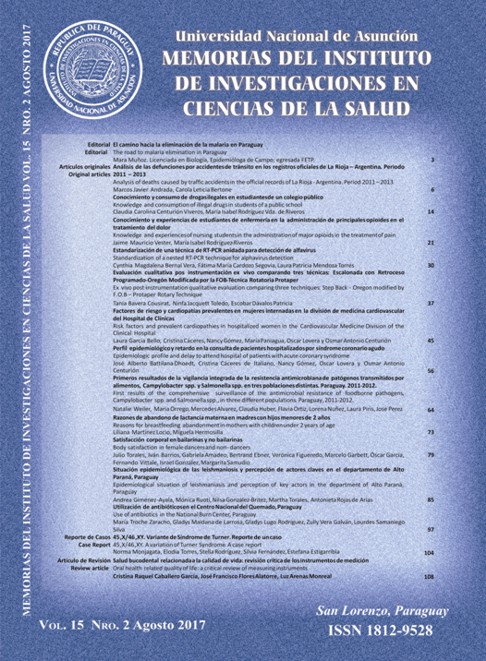Factores de riesgo y cardiopatías prevalentes en mujeres internadas en la división de medicina cardiovascular del Hospital de Clínicas
Palabras clave:
Factores de riesgo cardiovascular, Mujeres hospitalizadas, Síndrome coronario agudo.Resumen
La representación de las mujeres ha sido marginal en la mayoría de los ensayos clínicos o registros dedicados a las enfermedades cardiovasculares (ECV). Por eso, recientemente, se ha adoptado una política de estimular la inclusión de mujeres en los ensayos clínicos. En este estudio descriptivo retrospectivo y de corte transversal, nos hemos propuesto determinar la forma de presentación de las cardiopatías, describir los factores de riesgo cardiovasculares presentes en estas pacientes, determinar el número de mujeres que presentaron cardiopatía isquémica, y establecer el tratamiento recibido por las mujeres que presentaron cardiopatía isquémica en mujeres internadas en la División de Medicina Cardiovascular del Hospital de Clínicas. El estudio incluyó un total de 250 pacientes, de los cuales 187 (75%) correspondían al sexo masculino y 63 (25%) al sexo femenino. Las edades de las mujeres se encontraban entre 25 y 94 años (60±7,3 años). Las mujeres estudiadas presentaron: insuficiencia cardiaca 26 (41%), síndromes coronarios agudos 20 (32%), valvulopatías 8 (13%), bloqueo AV completo 7 (11%) y otros 2 (3%). De las mujeres con síndrome coronario agudo, 3 pacientes tuvieron enfermedad de 3 vasos, 1 sola tuvo coronarias normales, y 8 (40%) tenían lesiones de la arteria descendente anterior. Los factores de riesgo más frecuentes fueron el sedentarismo en la totalidad de las mujeres, la hipertensión arterial en 55 (87%), dislipidemias en 39 (62%), obesidad en 34 (54%), diabetes mellitus tipo 2 en 12 (19%) y tabaquismo en 12 pacientes (19%). La magnitud del riesgo cardiovascular de la mujer depende no solamente de la alteración de un parámetro sino también de la presencia de otros factores de riesgo, razón por la cual se requiere de un manejo multifactorial integral dentro del concepto de riesgo cardiovascular global en la mujer.
Descargas
Citas
Smith SC Jr, Blair SN, Bonow RO, Brass LM, Cerqueira MD, Dracup K et al. AHA/ACC scientific statement: AHA/ACC guidelines for preventing heart attack and death in patients with atherosclerotic cardiovascular disease: 2001 update: a statement for healthcare professionals from the American Heart Association and the American College of Cardiology. Circulation. 2001; 104:1577–9.
Mosca L, Grundy SM, Judelson D, King K, Limacher M, Oparil S, et al. Guide to preventive cardiology in women. Circulation. 1999; 99:2480-4.
Mosca L, Grundy SM, Judelson D, King K, Limacher M, Oparil S, et al. Guide to preventive cardiology in women. Circulation. 1999; 99:2480-4.
Mosca L, Appel LJ, Benjamin EJ, Berra K, Chandra-Strobos N, Fabunmi RP, et al. Evidence-based guidelines for cardiovascular disease prevention in women. Circulation. 2004; 109:672-93.
Mosca L, Ferris A, Fabunmi R, Robertson RM. Tracking women's awareness of heart disease. An American Heart Association National Study. Circulation. 2004; 109:573-9.
Pearson TA, Blair SN, Daniels SR, Eckel RH, Fair JM, Fortmann SP et al. AHA guidelines for primary prevention of cardiovascular disease and stroke: 2002 update: consensus panel guide to comprehensive risk reduction for adult patients without coronary or other atherosclerotic vascular diseases. American Heart Association Science Advisory and Coordinating Committee. Circulation. 2002; 106:388-391.
Mosca L, Ferris A, Fabunmi R, Robertson RM. Tracking women's awareness of heart disease. An American Heart Association National Study. Circulation. 2004; 109:573-9.
Pearson TA, Blair SN, Daniels SR, et al. AHA guidelines for primary prevention
of cardiovascular disease and stroke: 2002 update: consensus panel guide to comprehensive risk reduction for adult patients without coronary or other atherosclerotic vascular diseases. American Heart Association Science Advisory and Coordinating Committee. Circulation. 2002; 106:388-91.
Blomkalns AL, Chen AY, Hochman JS, Peterson ED, Trynosky K, Diercks DB, et al. Gender disparities in the diagnosis and treatment of non-ST-segment elevation acute coronary syndromes: large scale observations from the CRUSADE (Can Rapid Risk Stratification of Unstable Angina Patients Suppress Adverse Outcomes with Early implementation of the American College of Cardiology/American Heart Association Guidelines) National Quality Improvement Initiative. J Am Coll Cardiol. 2005; 45:832-837.
Murga N, Pedreira M, Mazón P, Alonso A. Temas de actualidad en cardiología clínica y extrahospitalaria. Un nuevo proyecto: enfermedad cardiovascular en la mujer. Rev Esp Cardiol. 2006; 59 (Supl1):99-104.
Murga N, Pedreira M, Mazón P, Alonso A. Temas de actualidad en cardiología clínica y extrahospitalaria. Un nuevo proyecto: enfermedad cardiovascular en la mujer. Rev Esp Cardiol. 2006; 59 (Supl1):99-104.
Stramba-Badiale M, Priori SG. Gender-specific prescription for cardiovascular diseases? Eur Heart J. 2005; 26:1571-2.
Merz NB, Bonow RO, Sopko G, Balaban RS, Cannon III RO, Gordon D, et al. Women's Ischemic Syndrome Evaluation. Current status and future research directions. Report on the National Heart, Lung and Blood Institute Workshop October 2-4, 2002. Executive summary. Circulation. 2004; 109:805-807.
Alfonso F, Bermejo J, Segovia J. Revista Española de Cardiología 2005: actividad y reconocimiento científico. Rev Esp Cardiol. 2005; 58:1482-7.
Ridker PM, Cook NR, Lee IM, Gordon D, Gaziano JM, Manson JE, et al. A randomized trial of low dose aspirin in the primary prevention of cardiovascular disease inwomen. N Engl J Med. 2005; 352:1293-304.
Ridker PM, Cook NR, Lee IM, Gordon D, Gaziano JM, Manson JE, et al. A randomized trial of low dose aspirin in the primary prevention of cardiovascular disease inwomen. N Engl J Med. 2005; 352:1293-304.
Mieres JH, Shaw LJ, Arai A, Budoff MJ, Flamm SD, Hundley G, et al. Role of non-invasive testing in the clinical evaluation of women with suspected coronary artery disease. Consensus statement from the Cardiac Imaging Committee, Council on Clinical Cardiology, and the Cardiovascular Imaging and Intervention Committee, Council on Cardiovascular Radiology and Intervention, American Heart Association. Circulation. 2005; 111:682-96.
Lansky AJ, Hochman JS, Ward PA, Mintz GS, Fabunmi R, Berger PB, et al. Percutaneous coronary interventions and adjunctive pharmacotherapy in women. A statement for healthcare professionals from the American Heart Association. Circulation. 2005; 111:940-53.
Wallentin L, Lagerqvist B, Husted S, Kontny F, Stahle E, Swahn E. Outcome at 1 year after an invasive compared with a non-invasive strategy in unstable coronary artery disease. The FRISC II invasive randomised trial. Lancet. 2000; 356:9-16.
Boersma E, Harrington RA, Moliterno DJ, White H, Theroux P, Van de Werf F, et al. Platelet glycoprotein IIbIIIa inhibitors in acute coronary syndromes: a meta-analysis of all major randomized clinical trials. Lancet. 2002; 359:189-98.
Ahumada M, Cabadés A, Valencia J, Cebrián J, Payá E, Morillas P, et al. El reinfarto como complicación del infarto agudo de miocardio. Datos del registro PRIMVAC. Rev Esp Cardiol. 2005; 58:13-9.
Núñez J, Fácila L, Lácer A, Sanchís J, Bodí V, Bertomeu V, et al. Valor pronóstico del recuento leucocitario en el infarto agudo de miocardio: mortalidad a largo plazo. Rev Esp Cardiol. 2005; 58:631-9.
Woodfiled SL, Lundergan CG, Reiner JS. Gender and acute myocardial infarction: is there a different to thrombolysis? J Am Coll Cardiol. 1997; 29:35-42.
Alfonso F, Macaya C, Iñiguez A, Banuelos C, Rodrigo JL, García Espinosa A, et al. Perfil clínico y resultados de la angioplastia coronaria en mujeres. Comparación con el varón. Rev Esp Cardiol. 1989; 42:359-66.
Alfonso F, Hernández R, Bañuelos C, Fernández-Ortiz A, Escaned J, Sabate M, et al. Initial results and long-term clinical and angiographic outcome of coronary stenting in women. Am J Cardiol 2000;86:1380-3.
Alfonso F. Restenosis after coronary stenting: the «gender paradox». Eur Heart J. 2003; 24:2239.
Blankstein R, Ward RP, Arnsdorf F, Jones B, Lou YB, Pine M. Female gender is an independent predictor of operative mortality after coronary artery bypass graft surgery: contemporary analysis of 31 midwestern hospitals. Circulation. 2005; 112 Suppl:I323-7.
Di Carlo A, Lamassa M, Baldereschi M, Pracucci G, Basile AM, Wolfe CD, et al. Sex differences in the clinical presentation, resource use, and 3-months outcome of acute stroke in Europe. Data from a multicenter, multinational, hospital-based registry. Stroke. 2003; 34:1114-9.
Ortlepp JR, Schmitz F, Mevissen V, Weiss S, Huster J, Dronskowski R, et al. The amount of calcium-deficient hexagonal hydroxyapatite in aortic valves is influenced by gender and associated with genetic polymorphisms in patients with severe calcific aortic stenosis. Eur Heart J. 2004; 25:514-22.
Orlowska-Baranowska E, Placha G, Gaciong Z, Baranowski R, Zakrzewski D, Michalek P, et al. Influence of ACE I/D genotypes on left ventricular hypertrophy in aortic stenosis: gender-related differences. J Heart Valve Dis. 2004; 13:574-81.
Carroll JD, Carroll EP, Feldman T, Ward DM, Lang RM, McGaughey D, et al. Sex-associated differences in left ventricular function in aortic stenosis in the elderly. Circulation. 1992; 86:1099-107.
Roberts WC, Ko JM. Relation of weights of operatively excised stenotic aortic valves to preoperative transvalvular peak systolic pressure gradients and to calculated aortic valve areas. J Am Coll Cardiol. 2004; 44:1847-55.
Swedberg K, Cleland J, Dargie H, Drexler H, Follath F, Komajda M, et al. Guías de práctica clínica sobre el diagnóstico y tratamiento de la insuficiencia cardiaca crónica. Rev Esp Cardiol. 2005; 58:1062-92.
Sheppard R, Behlouli H, Richard H, Pilote L. Effect of gender on treatment, resource utilization, and outcomes in congestive heart failure in Quebec, Canada. Am J Cardiol. 2005; 95:955-9.
Komajda M, Follath F, Swedberg K, Cleland J, Aguilar JC, Cohen-Solal A, et al. The EuroHeart Failure Survey programme-a survey on the quality of care among patients with heart failure in Europe. Part 2: treatment. Eur Heart J. 2003; 24:464-74.
Olivotto I, Maron MS, Adabag AS, Casey SA, Vargiu D, Link MS, et al. Gender-related differences in the clinical presentation and outcome of hypertrophic cardiomyopathy. J Am Coll Cardiol. 2005; 46:480-7.
Kannel WB, Wilson PWF, D'Agostino RB, Cobb J. Sudden coronary death in women. Am Heart J. 1998; 136:205-12.
Albert CM, Chae CA, Grodstein F, Rose LM, Rexrode KM, Ruskin JN, et al. Prospective study of sudden cardiac death among women in the United States. Circulation. 2003; 107:2096-101.
Lessmeier TJ, Gamperling D, Johnson-Liddon V, Fromm BS, Steinman RT, Meissner MD, et al. Unrecognized paroxismal supraventricular tachycardia. Potential for misdiagnosis as panic disorder. Arch Intern Med. 1997; 157:537-43.
Dagres N, Clague JR, Breithardt G, Borggrefe M. Significant gender-related differences in radiofrequency catheter ablation therapy. J Am Coll Cardiol. 2003; 42:1103-7.
Hellerstein MK, Benowitz NL, Neese RA, Schawartz JM, Hoh R, Jacob P, et al. Effects of cigarette smoking and its cessation on lipid metabolism and events coronary artery in heavy smokers. J Clin Invest. 1994; 93:265-72.
Prescott E, Hippe M, Schnohr P, Hein HO, Vestbo J. Smoking and risk of myocardial infarction in women and men: longitudinal population study. BMJ. 1998; 316:1043-7.
Willett WC, Green A, Stampfer MJ, Speizer FE, Colditz GA, Rosner B, et al. Relative and absolute excess risk of coronary heart disease among women who smoke cigarettes. N Engl J Med. 1978; 317: 1303-9.
Hermanson B, Omenn GS, Kronmal RA, Gersh Bj, Participants in the Coronary Artery Surgery Study. Beneficial six-year outcome of smoking cessation in older men and women with coronary artery disease: results from the CASS Registry. N Engl J Med. 1988; 319:1365-9.
Stangl V, Witzel V, Baumann G, Stangl K. Current diagnostic concepts to detect coronary artery disease in
García et al Factores de riesgo y cardiopatías prevalentes en mujeres internadas
Anderson JL, Adams CD, Antman EM, Bridges CR, Califf RM, Casey DE Jr, et al. ACC/AHA 2007 guidelines for the management of patients with unstable angina/non–ST-elevation myocardial infarction: a report of the American College of Cardiology/American Heart Association Task Force on Practice Guidelines (Writing Committee to Revise the 2002 Guidelines for the Management of Patients With Unstable Angina/Non–ST-Elevation Myocardial Infarction). Circulation. 2007; 116:e148–e304.
Antman EM, Anbe DT, Armstrong PW, Bates ER, Green LA, Hand M, et al. ACC/AHA guidelines for the management of patients with ST-elevation myocardial infarction: a report of the American College of Cardiology/American Heart Association Task Force on Practice Guidelines (Committee to Revise the 1999 Guidelines for the Management of Patients With Acute Myocardial Infarction). Circulation. 2004; 110;e82-e293.
Organización Mundial de la Salud. Las mujeres y la salud. Datos de hoy, la agenda de mañana. Resumen analítico. WHO/IER/MHI/STM.09.1. Disponible en www.who.int.
Lloyd-Jones D, Adams R, Brown T, Carnethon M, Dai S, De Simone G, et al. Heart Disease and Stroke Statistics—2010 Update A Report From the American Heart Association. Circulation. 2010; 121:e1-e170.














